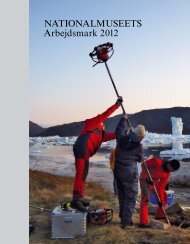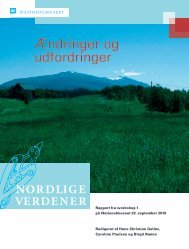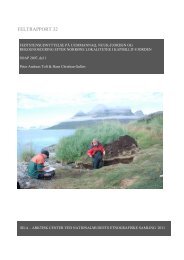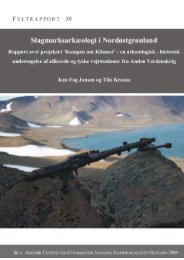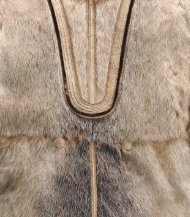The Border of Farming and the Cultural Markers - Nordlige Verdener
The Border of Farming and the Cultural Markers - Nordlige Verdener
The Border of Farming and the Cultural Markers - Nordlige Verdener
Create successful ePaper yourself
Turn your PDF publications into a flip-book with our unique Google optimized e-Paper software.
89<br />
<strong>the</strong> tool pre-forms or rough-outs were produced.<br />
Potentially related features such<br />
as small shelters <strong>and</strong> cairns can be recognized<br />
<strong>and</strong> at <strong>the</strong> Beorgs <strong>of</strong> Uyea <strong>the</strong>re is<br />
<strong>the</strong> well-known lintelled gallery, with one<br />
lateral side formed by a worked felsite<br />
dyke (Scott <strong>and</strong> Calder 1952). Three distinct<br />
zones can be recognized in <strong>the</strong> quarry<br />
complex; <strong>The</strong> Beorgs (<strong>of</strong> Uyea) / Pettadale<br />
Water, Midfield (east <strong>of</strong> Ronas Hill)<br />
<strong>and</strong> <strong>the</strong> central Lakel<strong>and</strong>s (<strong>the</strong> area between<br />
<strong>the</strong> two main quarry complexes).<br />
An important factor to be considered is<br />
<strong>the</strong> presence <strong>of</strong> blanket peat over much<br />
<strong>of</strong> <strong>the</strong> complex, particularly <strong>the</strong> lowerlying<br />
areas. <strong>The</strong>re are locations where<br />
<strong>the</strong> peat has been eroded <strong>and</strong> felsite<br />
can be seen but it is difficult to characterize<br />
<strong>the</strong> nature <strong>of</strong> this material. More<br />
broadly <strong>the</strong> issue is <strong>the</strong> amount <strong>and</strong><br />
character <strong>of</strong> evidence that may be concealed<br />
by <strong>the</strong> blanket peat cover.<br />
Preliminary analysis <strong>of</strong> museum collections<br />
indicates that <strong>the</strong> distribution <strong>of</strong> felsite<br />
products was widespread within but<br />
restricted to <strong>the</strong> Shetl<strong>and</strong> archipelago<br />
(see Ballin 2011c: 38-9). Combined with<br />
<strong>the</strong> exceptional quality <strong>of</strong> <strong>the</strong> evidence<br />
for quarrying <strong>and</strong> production in North<br />
Roe this geographic context facilitates<br />
following <strong>the</strong> cultural life <strong>of</strong> felsite objects<br />
through extraction, production, uselife<br />
<strong>and</strong> deposition, in some cases as<br />
spectacular caches or hoards <strong>and</strong> in o<strong>the</strong>r<br />
cases in houses, where <strong>the</strong>y mainly occur<br />
in fragmentary or re-used form. <strong>The</strong> distribution<br />
<strong>and</strong> context <strong>of</strong> <strong>the</strong>se artifacts<br />
can be taken as a proxy for <strong>the</strong> amount<br />
<strong>and</strong> nature <strong>of</strong> exchange <strong>and</strong> contact within<br />
<strong>and</strong> between isl<strong>and</strong> communities in<br />
Shetl<strong>and</strong> <strong>and</strong> how this changed over time.<br />
This evidence provides a critically important<br />
research opportunity to examine<br />
<strong>the</strong> dynamics <strong>of</strong> isl<strong>and</strong> life <strong>and</strong> compare<br />
<strong>and</strong> contrast it with Neolithic societies<br />
elsewhere in Europe.<br />
<strong>Nordlige</strong> <strong>Verdener</strong><br />
Shetl<strong>and</strong>sprojekt




